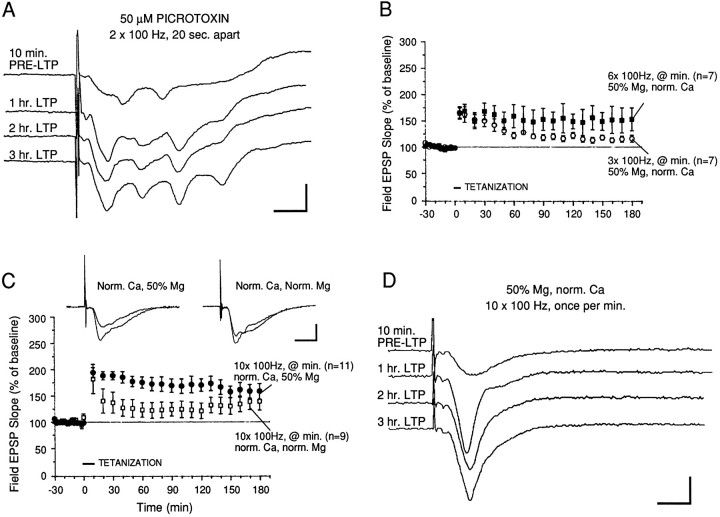Fig. 1.
Repeated tetanization induces short- or long-lasting potentiation (L-LTP) in the MPP. A, In the continual presence of 50 μm picrotoxin, two 100 Hz trains (20 sec apart) elicited L-LTP but also induced repetitive afterdischarges after evoked field EPSPs. Sample traces were recorded from a slice at times indicated. Calibration bars: 2 mV, 4 msec.B, Short-lasting potentiation was induced by three 100 Hz trains applied once every minute (at twice test pulse width) starting at “0 min” on the graph. With this protocol, the level of facilitation decayed to <125% of baseline 60–90 min after tetanization. With six trains of 100 Hz stimulation, a longer-lasting potentiation was induced that, although persistent, was variable in magnitude: 3 of 7 slices tested showed <50% facilitation 60 min after tetanization. In both protocols, normal calcium and 50% of normal magnesium levels were present in the saline. C, Ten 100 Hz trains induced a robust and persistent potentiation of MPP field EPSPs when applied in 50% Mg saline (filled circles; n = 11). In contrast, the same protocol elicited only a moderate level of facilitation in normal Mg saline (lower curve, open symbols). The levels of potentiation in normal Mg were significantly lower than those in the reduced Mg saline, beginning 20 min after tetanization and extending to 130 min after tetanization, and averaged only 122% of pretetanus baseline. Sample field EPSP traces were recorded 10 min before and 2 hr after tetanization. Calibration bars: 2 mV, 4 msec. D, Sample field EPSP traces measured from a slice that had been tetanized in reduced Mg saline showed robust potentiation and no repetitive afterdischarges (compare withA). Calibration bars: 2 mV, 4 msec.

